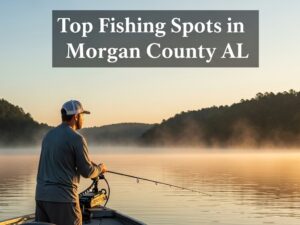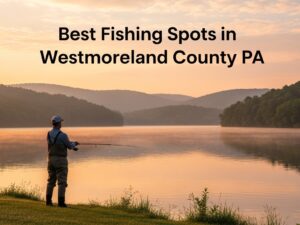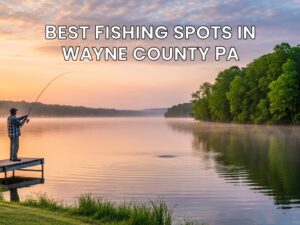Looking for the exact Monster Ledge GPS coordinates to enhance your offshore fishing adventure? This legendary fishing spot, located approximately 22 miles east of Manasquan Inlet off the Northern New Jersey coast, offers exceptional opportunities for shark and tuna fishing. The primary coordinates are 40°06.092'N 73°33.030'W (or 40.101533, -73.550500 in decimal degrees), positioning you directly over one of the most productive fishing grounds in the Mid-Atlantic region.
This comprehensive guide provides everything you need to navigate to Monster Ledge successfully, including multiple coordinate formats, detailed map information, and current fishing regulations. Whether you're targeting mako sharks, bluefin tuna, or other pelagic species, understanding the exact location and special rules will maximize your fishing success.
Understanding Monster Ledge GPS Coordinates
Monster Ledge sits at the eastern edge of the famous Mud Hole, forming part of a dramatic underwater canyon system that extends from the Verazano Bridge to Hudson Canyon. The ledge drops from approximately 150 feet to over 240 feet, creating an ideal habitat for baitfish and attracting apex predators throughout the fishing season.
Primary GPS Coordinate Formats
The Monster Ledge GPS coordinates can be entered into your marine electronics in three different formats:
Decimal Degrees (DD):
- Latitude: 40.101533
- Longitude: -73.550500
Degrees Decimal Minutes (DDM):
- 40° 6.092′ N
- 73° 33.03′ W
Degrees Minutes Seconds (DMS):
- 40° 6′ 5.5188″ N
- 73° 33′ 1.8″ W
Some navigational charts and experienced captains may reference slightly different coordinates such as N40° 07.900' W73° 34.500', which marks a nearby productive area along the same ledge structure. These variations typically represent different sections of the extended ledge system.
Distance From Major Inlets
Planning your trip requires understanding the distances from various departure points:
- Sandy Hook: 32 nautical miles
- Shark River Inlet: 22 nautical miles
- Manasquan Inlet: 30 nautical miles
- Barnegat Inlet: 35 nautical miles
These distances make Monster Ledge accessible for boats ranging from 23-foot center consoles to larger offshore vessels. However, weather conditions and sea state should always factor into your decision to make the run.
The Monster Ledge NJ Map Details
The Monster Ledge NJ map reveals this underwater structure as part of the larger Mud Hole complex, situated along an ancient riverbed channel. This geological formation creates dramatic depth changes that concentrate baitfish and attract predatory species year-round.
Navigational Chart References
Several marine charts accurately depict Monster Ledge's location and surrounding features:
Captain Seagull Chart No. OFGPS18 provides detailed bottom contours and marks numerous shipwrecks dotting the area. These wrecks add structure that holds additional fish, making the entire zone highly productive.
Homeport Charts and other specialized fishing maps clearly label Monster Ledge with GPS waypoints. Many charts show the ledge running between TD coordinates 13361.0-25908.3 (for those still using LORAN conversions).
The area appears on standard NOAA charts as part of the shipping lanes extending from Ambrose Channel, requiring vigilance for commercial traffic. Tankers frequently transit through these waters, following the deep water channel adjacent to the fishing grounds.
Bottom Structure and Depth Variations
The ledge creates a dramatic underwater cliff face that drops from the 150-foot plateau into depths exceeding 240 feet. This sheer wall concentrates currents and creates upwellings that bring nutrients to the surface, supporting the entire food chain.
The eastern edge proves most productive for drift fishing, allowing anglers to work baits along the drop-off where predators patrol. Multiple lobster pot lines mark the edge, providing additional structure and reference points for positioning.
Understanding these depth changes helps position your boat effectively. Most successful anglers start their drift on the shallow side and work deeper, adjusting their presentation as they cross the ledge face.
Navigation and Safety Considerations
Successfully reaching Monster Ledge requires careful planning and proper equipment. Your vessel needs sufficient range to cover the 44-60 mile round trip (depending on departure point), plus reserve fuel for drifting and potential weather changes.
Essential Navigation Equipment
Modern GPS plotters make finding Monster Ledge straightforward, but redundant navigation systems provide crucial backup. Consider these essential items:
- Primary GPS/chartplotter with updated charts
- Backup handheld GPS with waypoints saved
- Paper charts for the Mud Hole area
- VHF radio for weather updates and emergency communication
- Radar for fog navigation and vessel traffic
When selecting fishing boats for offshore adventures, ensure your vessel can handle the conditions typically encountered at Monster Ledge. The area experiences variable sea states, and afternoon winds often build during summer months.
Weather Windows and Sea Conditions
The best fishing at Monster Ledge occurs when water temperatures range between 62-69°F, typically from June through October. However, weather windows dictate safe access more than fishing productivity.
Monitor these conditions before departure:
- Seas under 3 feet for smaller boats (23-26 feet)
- Winds below 15 knots, preferably from the west
- Clear visibility (fog frequently affects the area)
- Stable or improving barometric pressure
Professional captains recommend departing two hours before sunrise to reach the grounds at prime fishing time. This schedule also allows return before afternoon sea breezes develop.
The Monster Ledge Special Regulations
The Monster Ledge Special regulations encompass both federal and state requirements for offshore fishing. Understanding these rules ensures legal compliance and sustainable fishing practices.
Federal HMS Permit Requirements
Fishing for sharks and tuna at Monster Ledge requires an HMS (Highly Migratory Species) permit when in federal waters. The ledge sits beyond the three-mile state water boundary, making federal regulations applicable.
Key federal requirements include:
- Valid HMS Angling or Charter/Headboat permit
- Compliance with current retention limits
- Mandatory use of non-offset circle hooks for sharks
- 24-hour reporting for billfish and bluefin tuna landings
The NOAA Fisheries HMS Management Division provides current regulations and permit applications. Regulations change seasonally, so verify current rules before each trip.
New Jersey State Regulations
While Monster Ledge lies in federal waters, New Jersey regulations apply to fish landed at state ports. Important state rules include:
Shark Regulations:
- Aggregated Large Coastal and Hammerhead sharks closed May 15 - July 15
- Non-stainless steel circle hooks required (except with artificial lures)
- Minimum size limits vary by species
- All sharks must retain fins, head, and tail naturally attached
Tuna Regulations:
- Size and bag limits change throughout the season
- Curved fork length measurements required
- Recreational retention may close without notice when quotas are met
The New Jersey Division of Fish and Wildlife maintains current marine fishing regulations. Check for emergency closures or regulation changes before each trip.
Special Area Considerations
Monster Ledge sits within active shipping lanes, requiring extra vigilance. Large vessels have restricted maneuverability and cannot avoid smaller boats. Monitor VHF Channel 16 and maintain proper lookout at all times.
Commercial draggers frequently work the area, especially during squid season. While their discards can trigger feeding frenzies, maintain safe distance from working commercial vessels. Never approach within 500 feet of active trawling operations.
The area's popularity means weekend crowds during prime season. Radio etiquette and courtesy preserve the experience for everyone. Avoid crowding other boats and respect established drift patterns.
Fishing Techniques and Target Species
Monster Ledge attracts diverse species throughout the season, with sharks and tuna being primary targets. Understanding seasonal patterns and effective techniques maximizes success.
Seasonal Species Availability
June - July: Early season brings school bluefin tuna and the first mako sharks. Water temperatures gradually warm, triggering migrations.
August - September: Peak season offers excellent mako and blue shark fishing. Larger bluefin appear, and mahi congregate around lobster pot buoys.
October: Late season produces the largest bluefin before they migrate south. Brown sharks become more common as water cools.
Proven Fishing Methods
Drift Fishing: The most popular technique involves establishing a chum slick while drifting the eastern edge. Deploy baits at varying depths to cover the water column.
Trolling: Cedar plugs, spreader bars, and ballyhoo prove effective for tuna. Troll parallel to the ledge, working both shallow and deep zones.
Chunking: Anchoring or power-drifting while chunking butterfish attracts tuna during slack tide periods.
When setting up your marine equipment, quality electronics help locate bait schools and temperature breaks. Modern marine fishing technology includes side-scan sonar that reveals bottom structure and suspended fish.
Essential Gear and Tackle
Proper tackle selection ensures you can handle the powerful fish inhabiting Monster Ledge. These apex predators demand quality equipment and proper technique.
Recommended Rod and Reel Combinations
For Sharks:
- 50-80 class conventional reels
- 6-7 foot stand-up rods rated 50-100 pounds
- 80-100 pound monofilament or braided line
- Wire leaders (400-pound test minimum)
For Tuna:
- 30-50 class spinning or conventional reels
- Medium-heavy rods with quality components
- 65-pound braided line with fluorocarbon leaders
- Quality drag systems essential for long runs
Terminal Tackle Essentials
Stock these items for successful trips:
- Non-offset circle hooks (sizes 8/0 to 16/0)
- Fluorocarbon leaders (60-100 pound test)
- Wire leaders for sharks
- Quality swivels and crimps
- Release tools and gloves
Safety Protocols and Best Practices
Offshore fishing at Monster Ledge demands respect for conditions and proper safety preparation. These waters can change quickly, turning pleasant conditions dangerous.
Required Safety Equipment
Beyond Coast Guard requirements, consider these essential items:
- EPIRB or personal locator beacon
- Life raft for trips beyond 20 miles
- Satellite communication device
- First aid kit with trauma supplies
- Extra fuel (minimum 1/3 reserve)
Emergency Procedures
Establish clear emergency protocols before departure. Ensure all crew members know:
- Location of safety equipment
- VHF emergency procedures
- Man overboard response
- Basic first aid for hooks and cuts
File a float plan with someone ashore, including intended return time and specific fishing location. This information proves invaluable if emergency assistance becomes necessary.
Frequently Asked Questions
What are the exact GPS coordinates for Monster Ledge?
The primary Monster Ledge GPS coordinates are 40° 6.092′ N, 73° 33.03′ W (or 40.101533, -73.550500 in decimal degrees). Some charts show alternate coordinates of N40° 07.900' W73° 34.500' for nearby productive areas along the same structure.
How far offshore is Monster Ledge from Manasquan Inlet?
Monster Ledge lies approximately 30 nautical miles from Manasquan Inlet, though some sources cite 22 miles to the nearest edge of the structure. Plan for a 60-mile round trip plus drifting distance.
What size boat do I need to reach Monster Ledge safely?
While boats as small as 23 feet make the trip in good conditions, vessels 26 feet or larger provide better safety margins. Consider sea conditions, fuel capacity, and crew experience when deciding.
When is the best time to fish Monster Ledge?
Peak fishing occurs from June through October when water temperatures range 62-69°F. August and September typically offer the most consistent action for both sharks and tuna.
Do I need special permits to fish at Monster Ledge?
Yes, you need an HMS permit for sharks and tuna in federal waters. New Jersey saltwater registration is also required. Check current regulations as requirements change seasonally.
What are the depth ranges at Monster Ledge?
The ledge structure ranges from approximately 150 feet on the shallow side to over 240 feet at the base. Most productive fishing occurs along the drop-off between these depths.
Conclusion
Monster Ledge stands as one of the premier offshore fishing destinations accessible to recreational anglers from the New Jersey coast. With precise GPS coordinates of 40° 6.092′ N, 73° 33.03′ W, this underwater structure consistently produces exceptional fishing for sharks, tuna, and other pelagic species.
Success at Monster Ledge requires careful planning, proper equipment, and respect for changing conditions. Understanding the Monster Ledge NJ map details, following the Monster Ledge Special regulations, and prioritizing safety ensures memorable fishing experiences. Whether you're an experienced offshore angler or planning your first trip to these productive waters, Monster Ledge offers world-class fishing opportunities just 22-32 miles from New Jersey's inlets.



